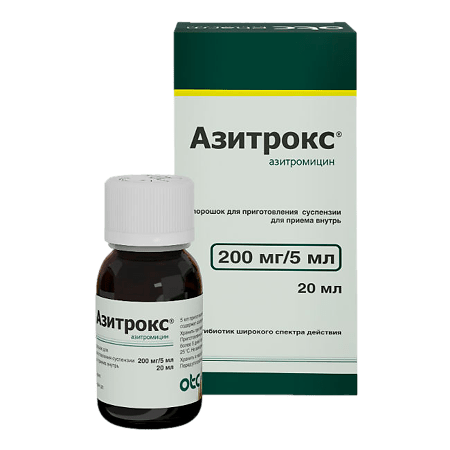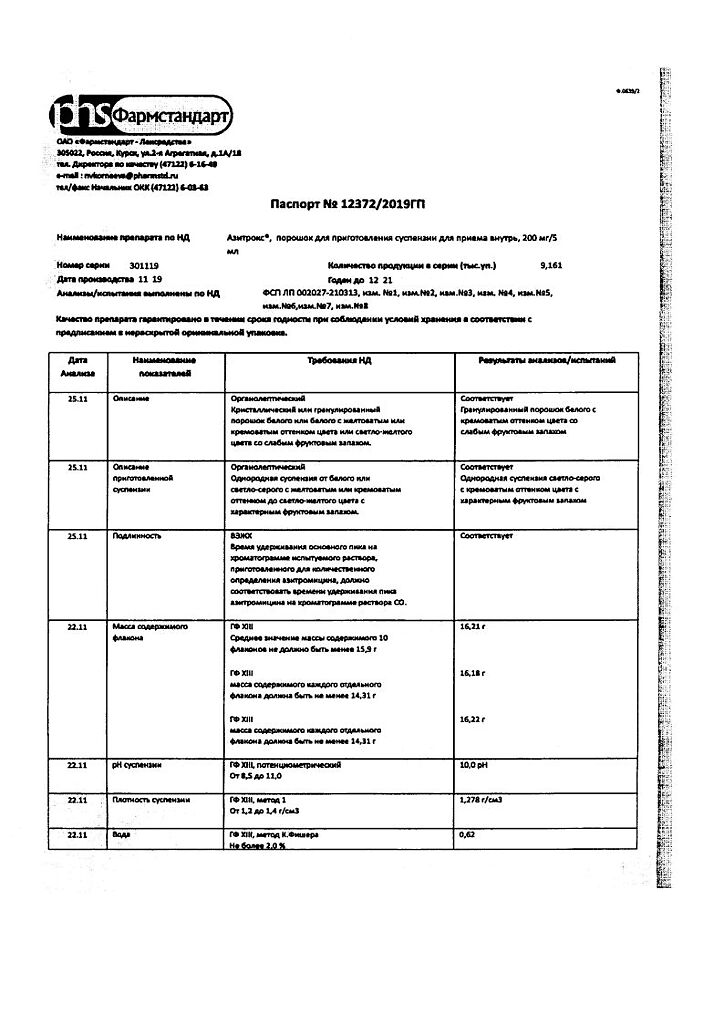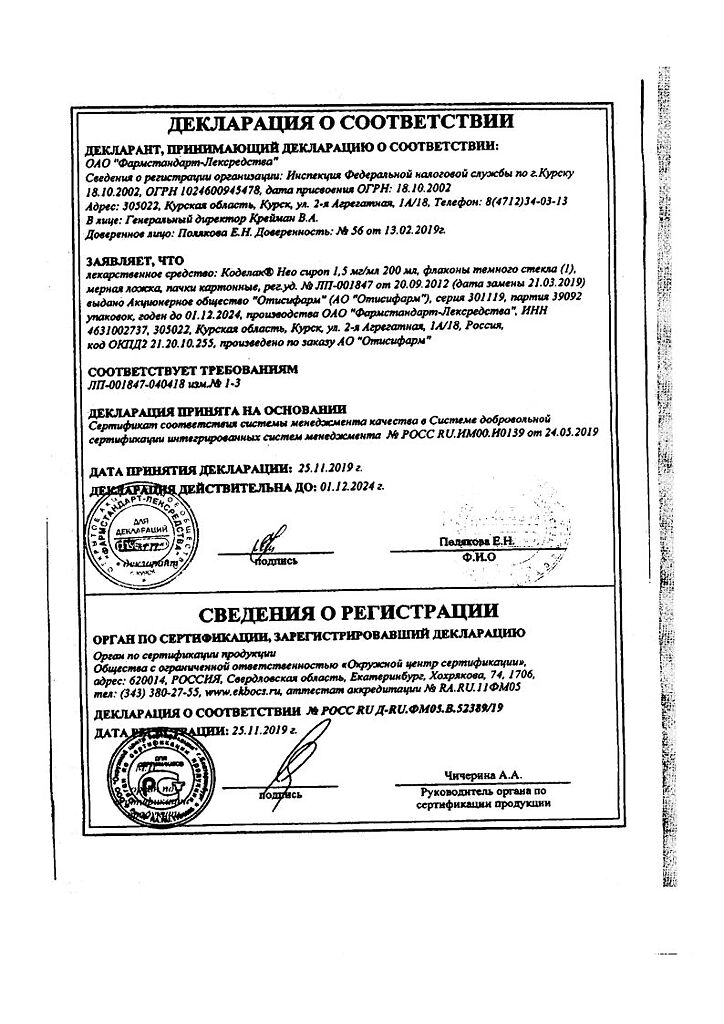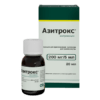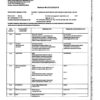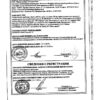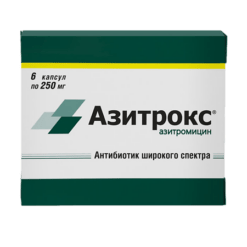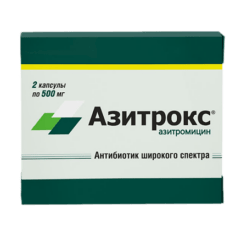No products in the cart.
Azitrox, 200 mg/5 ml 15.9g
€6.46 €6.14
Description
Vaginal infections, Guillotine, Otitis media, Infectious diseases, Pharyngitis, Angina, Skin infections, Respiratory tract infections, Urethritis, Bronchitis, Urinary tract infections, Sinusitis, Tonsillitis, Pneumonia
According to the FDA (2020), oral azithromycin is indicated for the treatment of patients with mild to moderate infections (pneumonia: see “Precautions”). “Precautions”) caused by susceptible strains of the indicated microorganisms under certain conditions listed below.
Adults
Acute bacterial exacerbations of chronic obstructive pulmonary disease caused by Haemophilus influenzae, Moraxella catarrhalis or Streptococcus pneumoniae.
Acute bacterial sinusitis caused by Haemophilus influenzae, Moraxella catarrhalis or Streptococcus pneumoniae.
Out-of-hospital pneumonia caused by Chlamydophila pneumoniae, Haemophilus influenzae, Mycoplasma pneumoniae or Streptococcus pneumoniae in patients who are prescribed oral therapy.
. Azithromycin should not be used in patients with pneumonia who are not indicated for oral therapy because of moderate to severe disease or when risk factors are present, such as patients with cystic fibrosis, patients with nosocomial infections, patients with known or suspected bacteremia, patients requiring hospitalization, elderly or frail patients, patients with serious underlying health problems that may impede their ability to respond to disease (including immunodeficiency or functional
Pharyngitis/tonsillitis caused by Streptococcus pyogenes is an alternative to first-line therapy in patients in whom first-line therapy cannot be used.
Note. Penicillin administered by injection/m is usually the drug of choice in the treatment of infections caused by Streptococcus pyogenes and the prevention of rheumatic fever. Azithromycin is often effective in eradicating sensitive strains of Streptococcus pyogenes from the nasopharynx. Since some strains are resistant to azithromycin, tests for azithromycin sensitivity should be performed during treatment of patients. There are no data confirming the effectiveness of azithromycin in the subsequent prevention of rheumatic fever.
Uncomplicated infections of the skin and skin structures caused by Staphylococcus aureus, Streptococcus pyogenes or Streptococcus agalactiae. Abscesses usually require surgical intervention.
Urethritis and cervicitis caused by Chlamydia trachomatis or Neisseria gonorrhoeae.
Infectious genital disease in men caused by Haemophilus ducreyi (Chancroid). Because of the small number of women included in clinical trials, the effectiveness of azithromycin in the treatment of chancroid in women has not been established.
Azithromycin should not be relied on at the recommended dose to treat syphilis. Antimicrobials used in high doses for short periods of time to treat nongonococcal urethritis may mask or delay the presentation of symptoms during the incubation period of syphilis. All patients with urethritis or cervicitis as a result of a sexually transmitted infection should have a serologic test for syphilis and appropriate cultures for gonorrhea at the time of diagnosis. If the infection is confirmed, appropriate antimicrobial therapy should be started and follow-up tests for these diseases should be performed.
At the beginning of treatment, appropriate tests should be performed to determine the pathogen and its sensitivity to azithromycin. Azithromycin therapy may be initiated before the results of these tests are available; once the results are available, antimicrobial therapy should be adjusted.
In order to prevent the development of drug-resistant bacteria and to maintain the effectiveness of azithromycin and other antibacterial drugs, azithromycin should only be used to treat or prevent infections for which sensitive bacteria are proven or reasonably suspected to cause them. When culture and sensitivity information is available, it should be considered when selecting or modifying antibiotic therapy. In the absence of such data, the local epidemiologic situation and sensitivity patterns may contribute to the empirical choice of therapy.
Pediatric patients
Acute otitis media caused by Haemophilus influenzae, Moraxella catarrhalis or Streptococcus pneumoniae.
Out-of-hospital pneumonia caused by Chlamydophila pneumoniae, Haemophilus influenzae, Mycoplasma pneumoniae or Streptococcus pneumoniae in patients who are indicated for oral therapy.
. Azithromycin should not be used in pediatric patients with pneumonia who are not indicated for oral therapy because of moderate to severe disease or when risk factors are present, such as patients with cystic fibrosis, patients with hospital-acquired infections, patients with known or suspected bacteremia, patients requiring hospitalization, patients with serious underlying health problems that may impede the ability to respond to disease (including immune deficiency or functional asperity).
Pharyngitis/tonsillitis caused by Streptococcus pyogenes is an alternative to first-line therapy in patients in whom first-line therapy cannot be used.
Note. Penicillin administered by injection/m is usually the drug of choice in the treatment of infections caused by Streptococcus pyogenes and the prevention of rheumatic fever. Azithromycin is often effective in eradicating sensitive strains of Streptococcus pyogenes from the nasopharynx. Since some strains are resistant to azithromycin, tests for azithromycin sensitivity should be performed during treatment of patients. There are no data confirming the efficacy of azithromycin in the subsequent prevention of rheumatic fever.
At the beginning of treatment, appropriate tests should be performed to determine the causative agent and its sensitivity to azithromycin. Azithromycin therapy may be initiated before the results of these tests are available; antimicrobial therapy should be adjusted as soon as the results are available.
.
Indications
Indications
According to the FDA (2020), oral azithromycin is indicated for the treatment of patients with mild to moderate infections (pneumonia: see Precautions) caused by susceptible strains of these organisms under certain conditions listed below.
Adults
Acute bacterial exacerbations of chronic obstructive pulmonary disease caused by Haemophilus influenzae, Moraxella catarrhalis or Streptococcus pneumoniae.
Acute bacterial sinusitis caused by Haemophilus influenzae, Moraxella catarrhalis or Streptococcus pneumoniae.
Community-acquired pneumonia caused by Chlamydophila pneumoniae, Haemophilus influenzae, Mycoplasma pneumoniae, or Streptococcus pneumoniae in patients prescribed oral therapy.
Azithromycin should not be used in patients with pneumonia who are not candidates for oral therapy because of moderate to severe disease or the presence of risk factors, such as patients with cystic fibrosis, patients with hospital-acquired infections, patients with known or suspected bacteremia, patients requiring hospitalization, elderly or debilitated patients, patients with serious underlying health problems that may interfere with the ability to respond to disease (including immunodeficiency or functional asplenia).
Pharyngitis/tonsillitis due to Streptococcus pyogenes is an alternative to first-line therapy in patients for whom first-line therapy cannot be used.
Note. Penicillin administered intramuscularly is usually the drug of choice for the treatment of infections caused by Streptococcus pyogenes and the prevention of rheumatic fever. Azithromycin is often effective in eradicating susceptible strains of Streptococcus pyogenes from the nasopharynx. Because some strains are resistant to azithromycin, azithromycin susceptibility testing should be performed during treatment of patients. There are no data confirming the effectiveness of azithromycin in the subsequent prevention of rheumatic fever.
Uncomplicated infections of the skin and skin structures caused by Staphylococcus aureus, Streptococcus pyogenes or Streptococcus agalactiae. Abscesses usually require surgery.
Urethritis and cervicitis caused by Chlamydia trachomatis or Neisseria gonorrhoeae.
An infectious disease of the genital organs in men caused by Haemophilus ducreyi (chancroid). Due to the small number of women included in clinical trials, the effectiveness of azithromycin in the treatment of chancroid in women has not been established.
Azithromycin should not be relied upon at the recommended dose to treat syphilis. Antimicrobial agents used in high doses for short periods of time to treat nongonococcal urethritis may mask or delay the onset of symptoms during the incubation period of syphilis. All patients with urethritis or cervicitis due to sexually transmitted infection should undergo serological testing for syphilis and appropriate cultures for gonorrhea at the time of diagnosis. If infection is confirmed, appropriate antimicrobial therapy should be initiated and subsequent testing for these diseases should be performed.
Before starting treatment, appropriate tests should be performed to determine the pathogen and its sensitivity to azithromycin. Azithromycin therapy may be initiated before the results of these tests are known; once results are available, antimicrobial therapy should be adjusted.
To prevent the development of drug-resistant bacteria and maintain the effectiveness of azithromycin and other antibacterial drugs, azithromycin should be used only to treat or prevent infections that are proven or reasonably suspected to be caused by susceptible bacteria. When culture and susceptibility information is available, it should be considered when selecting or changing antibiotic therapy. In the absence of such data, local epidemiology and susceptibility patterns may guide empirical selection of therapy.
Pediatric patients
Acute otitis media caused by Haemophilus influenzae, Moraxella catarrhalis or Streptococcus pneumoniae.
Community-acquired pneumonia caused by Chlamydophila pneumoniae, Haemophilus influenzae, Mycoplasma pneumoniae or Streptococcus pneumoniae in patients for whom oral therapy is indicated.
Azithromycin should not be used in pediatric patients with pneumonia who are not candidates for oral therapy because of moderate to severe disease or the presence of risk factors, such as patients with cystic fibrosis, patients with hospital-acquired infections, patients with known or suspected bacteremia, patients requiring hospitalization, patients with serious underlying health problems that may interfere with the ability to respond to disease (including immunodeficiency or functional asplenia).
Pharyngitis/tonsillitis due to Streptococcus pyogenes is an alternative to first-line therapy in patients for whom first-line therapy cannot be used.
Note. Penicillin administered intramuscularly is usually the drug of choice for the treatment of infections caused by Streptococcus pyogenes and the prevention of rheumatic fever. Azithromycin is often effective in eradicating susceptible strains of Streptococcus pyogenes from the nasopharynx. Because some strains are resistant to azithromycin, azithromycin susceptibility testing should be performed during treatment of patients. There are no data confirming the effectiveness of azithromycin in the subsequent prevention of rheumatic fever.
Before starting treatment, appropriate tests should be performed to determine the pathogen and its sensitivity to azithromycin. Azithromycin therapy may be initiated before the results of these tests are known; once results are available, antimicrobial therapy should be adjusted.
Pharmacological effect
Pharmacological effect
Pharmacological group
Special instructions
Special instructions
Hypersensitivity
Serious allergic reactions, including angioedema, anaphylaxis and dermatological reactions, including angioedema, have rarely been observed in patients receiving azithromycin. Stevens-Johnson syndrome and toxic epidermal necrolysis. Deaths have been reported, although rare. Despite initially successful symptomatic treatment of allergic symptoms, after cessation of symptomatic therapy, some patients experienced a recurrence of allergic symptoms shortly thereafter without further exposure to azithromycin. These patients required long-term observation and symptomatic treatment. The relationship of these episodes to the long tissue half-life of azithromycin and subsequent prolonged antigen exposure is currently unknown.
If an allergic reaction occurs, azithromycin should be discontinued and appropriate therapy should be prescribed. Doctors should be aware that allergic symptoms may reappear after symptomatic therapy is stopped.
Hepatotoxicity
Liver dysfunction, hepatitis, cholestatic jaundice, liver necrosis and liver failure have been reported, some of which have resulted in death. Azithromycin should be discontinued immediately if signs and symptoms of hepatitis occur.
Treatment of pneumonia
The safety and effectiveness of azithromycin is indicated only for the treatment of community-acquired pneumonia caused by Chlamydia pneumoniae, Haemophilus influenzae, Mycoplasma pneumoniae, or Streptococcus pneumoniae in patients for whom oral therapy is indicated. Azithromycin should not be used in patients with pneumonia who are not candidates for oral therapy because of moderate to severe disease or the presence of risk factors, such as patients with cystic fibrosis, patients with hospital-acquired infections, patients with known or suspected bacteremia, patients requiring hospitalization, elderly or debilitated patients, patients with serious underlying health problems that may interfere with the ability to respond to disease (including immunodeficiency or functional asplenia).
Diarrhea associated with Clostridium difficile
Clostridium difficile-associated diarrhea has been reported with virtually all antibacterial agents, including azithromycin injection, and can range in severity from mild diarrhea to fatal colitis. Treatment with antibacterial agents leads to modification of the normal flora of the large intestine and excessive growth of C. difficile.
Strains of C. difficile produce toxins A and B, which cause diarrhea. Hypertoxin-producing strains of C. difficile result in increased risk of morbidity and mortality as these infections may be resistant to antimicrobial therapy and require colectomy. The possibility of C. difficile-associated diarrhea should be considered in all patients who complain of diarrhea after using antibacterial agents. A thorough history taking is necessary, because the development of C. difficile-associated diarrhea is possible within 2 months after the use of antibacterial drugs.
If C. difficile-associated diarrhea is suspected or confirmed, azithromycin should be discontinued and appropriate treatment should be initiated (including fluids and electrolytes, protein supplements, antibiotics to which C. difficile strains are susceptible), and surgical evaluation should be performed if clinically indicated.
QT prolongation
When treated with macrolides, incl. azithromycin, prolongation of cardiac repolarization and QT interval was observed, leading to the risk of developing cardiac arrhythmia and torsade de pointes. Cases of torsade de pointes have been reported during post-marketing surveillance in patients receiving azithromycin. The risk of QT prolongation, which can be fatal, must be considered when assessing the risks and benefits of azithromycin in at-risk populations, including:
– patients with known prolongation of the QT interval, a history of torsade de pointes, congenital long QT syndrome, bradyarrhythmia or uncompensated heart failure;
– patients taking drugs that prolong the QT interval;
– patients with current proarrhythmic conditions, such as uncorrected hypokalemia or hypomagnesemia, clinically significant bradycardia, as well as patients receiving class IA (quinidine, procainamide) or class III antiarrhythmic drugs (dofetilide, amiodarone, sotalol).
Elderly patients may be more sensitive to the effects of drugs that cause QT interval prolongation.
Exacerbation of myasthenia gravis
Exacerbation of symptoms of myasthenia gravis and the occurrence of myasthenic syndrome have been reported in patients receiving azithromycin therapy.
Development of resistant bacteria
Prescribing azithromycin in the absence of a confirmed/suspected bacterial infection or for prophylactic indications is unlikely to benefit the patient and increases the risk of developing resistant bacteria.
Liver dysfunction in adults
The pharmacokinetics of azithromycin in patients with impaired liver function has not been established.
Since azithromycin is eliminated primarily through the liver, caution should be exercised when prescribing azithromycin to patients with impaired liver function.
Renal dysfunction in adults
For patients with renal failure and GFR ≥80 ml/min, no dose adjustment is recommended. The AUC0-120 value was similar in people with GFR 10-80 ml/min and people with normal kidney function, whereas in people with GFR <10 ml/min it increased by 35% compared with that with normal kidney function. Caution should be exercised when taking azithromycin in patients with severe renal impairment (GFR <10 mL/min) due to limited data.
Use in pediatrics
Acute otitis media. The safety and effectiveness of oral azithromycin for the treatment of acute otitis media in children under 6 months of age have not been established.
Acute bacterial sinusitis. The safety and effectiveness of treatment in pediatric patients with acute bacterial sinusitis less than 6 months of age have not been established. The use of oral azithromycin for the treatment of acute bacterial sinusitis in pediatric patients (6 months of age and older) is supported by adequate and well-controlled studies in adults, similar pathophysiology of acute sinusitis in adults and children, and studies of acute otitis media in pediatric patients.
Community-acquired pneumonia. The safety and effectiveness of treatment in pediatric patients with community-acquired pneumonia less than 6 months of age have not been established.
Safety and effectiveness for pneumonia caused by Chlamydophila pneumoniae and Mycoplasma pneumoniae have been documented in pediatric clinical trials.
Safety and efficacy for pneumonia caused by Haemophilus influenzae and Streptococcus pneumoniae have not been bacteriologically confirmed in pediatric clinical trials due to difficulties in obtaining samples. The use of azithromycin against these two organisms, however, is supported by adequate and well-controlled studies in adults.
Pharyngitis/tonsillitis. Safety and effectiveness in the treatment of pediatric patients under 2 years of age with pharyngitis/tonsillitis have not been established.
There have been no studies evaluating the use of repeated courses of therapy.
Application in geriatrics
The pharmacokinetic parameters of azithromycin in elderly volunteers (65–85 years) were similar to those in young volunteers (18–40 years) with a 5-day therapy regimen. No dose adjustment is required for elderly patients with normal renal and hepatic function with this dosage regimen.
In clinical trials of multiple doses of oral azithromycin, 9% of patients were at least 65 years of age (458/4949) and 3% of patients (144/4949) were over 75 years of age. No overall differences in safety or effectiveness were observed between these and younger patients, and other reported clinical experience has shown no difference in response between older and younger patients, but greater sensitivity in some older adults cannot be ruled out.
Elderly patients may be more at risk of developing torsade de pointes arrhythmias than younger patients.
Active ingredient
Active ingredient
Azithromycin
Composition
Composition
5 ml of the finished suspension contains:
azithromycin 200 mg.
Pregnancy
Pregnancy
Pregnancy
FDA category of effect on the fetus is B.
Teratogenic effects. Reproduction studies have been performed in rats and mice when administered orally at doses up to moderately toxic maternal concentrations (i.e., 200 mg/kg/day). These daily doses for rats and mice, based on body surface area, are estimated to be 4 and 2 times, respectively, the 500 mg daily dose for adults. Animal studies have not found any evidence of harm to the fetus due to the effects of azithromycin. However, adequate and well-controlled studies have not been conducted in pregnant women. Because animal reproduction studies do not always predict effects in humans, azithromycin should be used during pregnancy only when absolutely necessary.
Breastfeeding
Azithromycin has been reported to be excreted in human breast milk in small quantities. Caution should be exercised when using azithromycin in nursing women.
Contraindications
Contraindications
Hypersensitivity to azithromycin, erythromycin, any macrolide or ketolide antibiotics; history of cholestatic jaundice/liver dysfunction associated with previous use of azithromycin.
Side Effects
Side Effects
In clinical trials, most side effects reported were mild to moderate and reversible after discontinuation of azithromycin. Potentially serious side effects such as angioedema and cholestatic jaundice have been rarely reported. Approximately 0.7% of patients (adults and children) participating in the 5-day multiple-dose clinical trials discontinued azithromycin therapy due to treatment-related side effects. In adults receiving azithromycin 500 mg/day, the discontinuation rate due to treatment-related side effects was 0.6% after 3 days of treatment. In clinical trials in pediatric patients, when 30 mg/kg was administered either as a single dose of azithromycin or for 3 days, discontinuation of azithromycin due to treatment-associated side effects was approximately 1%. Most of the side effects that led to withdrawal were related to the gastrointestinal tract, incl. nausea, vomiting, diarrhea, or abdominal pain.
Clinical trial results
Because clinical trials are conducted under a different set of conditions, the incidence of adverse reactions observed in these clinical trials may not be the same as those obtained in other clinical trials and observed in clinical practice.
Adults
Multi-dose regimens. Overall, the most common treatment-related adverse reactions in adult patients receiving multiple doses of azithromycin were gastrointestinal effects. The most commonly reported adverse reactions were diarrhea/loose stools (4–5%), nausea (3%), and abdominal pain (2–3%).
No other treatment-related adverse events with an incidence greater than 1% were observed in patients receiving multiple doses of azithromycin.
Adverse reactions that occurred with an incidence of ≤1% included the following.
From the cardiovascular system: palpitations, chest pain.
From the gastrointestinal tract: dyspepsia, flatulence, vomiting, melena, cholestatic jaundice.
From the genitourinary system: candidiasis, vaginitis, nephritis.
From the nervous system: dizziness, headache, vertigo, drowsiness.
General: fatigue.
Allergic reactions: rash, skin itching, photosensitivity, angioedema.
Single-dose 1 g regimen: Overall, the most common side effects in patients receiving a single dose of azithromycin 1 g were related to the gastrointestinal system and were reported more frequently than in patients receiving a multiple-dose regimen.
Side effects observed in patients with a single dose of azithromycin with a frequency of 1% or more included diarrhea/loose stools (7%), nausea (5%), abdominal pain (5%), vomiting (2%), dyspepsia (1%), vaginitis (1%).
2 g single dose regimen: Overall, the most common side effects in patients receiving a single 2 g dose of azithromycin were related to the gastrointestinal system.
Side effects observed in patients with a single dose of azithromycin in this study with an incidence of 1% or more included nausea (18%), diarrhea/loose stools (14%), vomiting (7%), abdominal pain (7%), vaginitis (2%), dyspepsia (1%), dizziness (1%). Most complaints were of a moderate nature.
Pediatric patients
Single and multiple dose modes. The types of adverse events in pediatric patients were comparable to those in adults, with varying rates of occurrence for dosing regimens recommended in pediatric practice.
Acute otitis media: At the recommended total dosage of 30 mg/kg, the most common treatment-related adverse effects (≥1%) were diarrhea, abdominal pain, vomiting, nausea, and rash.
The frequency of side effects, depending on the dosage regimen, for 1-, 3- and 5-day dosing regimens was: diarrhea – 4.3; 2.6 and 1.8%; abdominal pain – 1.4; 1.7 and 1.2%; vomiting – 4.9; 2.3 and 1.1%; nausea – 1, 0.4 and 0.5%; rash – 1, 0.6 and 0.4%.
Community-Acquired Pneumonia: For the recommended dosage regimen of 10 mg/kg on day 1 followed by 5 mg/kg on days 2–5, the most common treatment-related adverse events were diarrhea/loose stools (5.8%), abdominal pain (1.9%), vomiting (1.9%), nausea (1.9%), and rash (1.6%).
Pharyngitis/tonsillitis: At the recommended dosing regimen of 12 mg/kg on days 1–5, the most common treatment-related adverse events were diarrhea (5.4%), abdominal pain (3.4%), vomiting (5.6%), nausea (1.8%), rash (0.7%), headache (1.1%).
No other treatment-related adverse events occurring with an incidence of >1% were observed in pediatric practice with any treatment regimen.
Side effects observed with an incidence of ≤1% included the following.
From the cardiovascular system: chest pain.
From the gastrointestinal tract: dyspepsia, constipation, anorexia, enteritis, flatulence, gastritis, jaundice, loose stools, oral candidiasis.
From the blood and lymphatic system: anemia, leukopenia.
From the nervous system: headache (with otitis media), hyperkinesia, dizziness, agitation, nervousness, insomnia.
General: fever, facial swelling, fatigue, fungal infection, malaise, pain.
Allergic: rash and allergic reaction.
From the respiratory system: increased cough, pharyngitis, pleural effusion, rhinitis.
From the skin and its appendages: eczema, fungal dermatitis, itching, sweating, urticaria, vesiculobullous rash.
From the senses: conjunctivitis.
Post-marketing experience
Adverse reactions reported during post-marketing experience with azithromycin in adults and/or pediatric patients for which a causal relationship has not been established include the following.
Allergic reactions: arthralgia, edema, urticaria and angioedema.
From the cardiovascular system: arrhythmia, including ventricular tachycardia and hypotension. There have been case reports of QT prolongation and torsade de pointes.
From the gastrointestinal tract: anorexia, constipation, dyspepsia, flatulence, vomiting/diarrhea, rarely leading to dehydration, pseudomembranous colitis, pancreatitis, oral candidiasis, pyloric stenosis, there are rare reports of changes in the color of the tongue.
Common: asthenia, paresthesia, fatigue, malaise and anaphylaxis (rarely fatal).
From the genitourinary system: interstitial nephritis, acute renal failure and vaginitis.
From the side of hematopoiesis: thrombocytopenia.
From the liver/biliary tract: adverse reactions associated with liver dysfunction.
From the nervous system: convulsions, dizziness/vertigo, headache, drowsiness, hyperactivity, nervousness, agitation and fainting.
Mental disorders: aggressive reaction and anxiety.
From the skin and its appendages: itching, serious skin reactions, including erythema multiforme, Stevens-Johnson syndrome, toxic epidermal necrolysis and DRESS syndrome.
Senses: Hearing disturbances, including hearing loss, deafness and/or tinnitus, and reports of distortion and/or loss of taste/smell.
Laboratory abnormalities
Adults
Clinically significant abnormalities (irrespective of drug-related) were reported during clinical trials with a frequency of more than 1%: decrease in Hb, hematocrit, lymphocytes, neutrophils and blood glucose, increase in serum CPK, potassium, ALT, GGT, AST, bilirubin, creatinine, blood glucose, platelet count, lymphocytes, neutrophils and eosinophils; with a frequency of less than 1%: leukopenia, neutropenia, decrease in sodium, potassium, platelet count, increase in the number of monocytes, basophils, bicarbonate, serum alkaline phosphate, bilirubin, LDH and phosphates. Most patients with elevated serum creatinine also had abnormal baseline values.
Changes in laboratory tests were reversible.
In multiple-dose clinical trials involving more than 5000 patients, 4 patients discontinued azithromycin therapy due to treatment-related liver enzyme abnormalities and 1 due to renal dysfunction.
Pediatric patients
One-, three- and five-day regimens. Laboratory data collected during comparative clinical trials using two 3-day regimens (30 or 60 mg/kg in divided doses for 3 days) or two 5-day regimens (30 or 60 mg/kg) in divided doses for 5 days) were similar for all azithromycin dosing regimens, with the most clinically significant laboratory abnormalities occurring in frequency 1–5%. Laboratory data for patients receiving 30 mg/kg as a single dose were collected in a single-center study. In this trial, absolute neutrophil counts between 500 and 1500 cells/mm3 were observed in 10 of 64 patients receiving 30 mg/kg as a single dose, 9 of 62 patients receiving 30 mg/kg for 3 days, and 8 of 63 control patients. No patient had an absolute neutrophil count <500 cells/mm3.
In a multiple-dose clinical trial involving approximately 4,700 pediatric patients, no patients had therapy discontinued due to treatment-related laboratory abnormalities.
Interaction
Interaction
Nelfinavir. Co-administration of nelfinavir at steady state with a single oral dose of azithromycin resulted in a significant increase in serum concentrations (Cmax and AUC) of azithromycin. Although azithromycin dosage adjustments are not recommended when taken in combination with nelfinavir, close monitoring is necessary for azithromycin side effects such as liver enzyme abnormalities and hearing impairment.
Warfarin. Although in a study of 22 healthy men, a 5-day course of azithromycin did not affect PT when subsequently dosed with warfarin, spontaneous post-marketing reports suggest that concomitant use of azithromycin may potentiate the effects of oral anticoagulants. PT should be carefully monitored if patients are receiving azithromycin and oral anticoagulants concomitantly.
Interaction studies have been conducted with azithromycin and other drugs that can be used simultaneously. When used in therapeutic doses, azithromycin had a moderate effect on the pharmacokinetics of atorvastatin, carbamazepine, cetirizine, didanosine, efavirenz, fluconazole, indinavir, midazolam, rifabutin, sildenafil, theophylline (iv and orally), triazolam, trimethoprim/sulfamethoxazole and zidovudine. Concomitant use with efavirenz or fluconazole had a moderate effect on the pharmacokinetics of azithromycin. Dose adjustment of the above drugs when used in combination with azithromycin is not recommended.
In clinical trials of azithromycin, no interactions were reported with the drugs listed below. However, no specific studies have been conducted to evaluate the potential interaction. Interaction was observed with other drugs from the macrolide group. Close monitoring of patients is recommended until additional data are available on the interaction of the following drugs with azithromycin: digoxin (increased digoxin concentrations); ergotamine or dihydroergotamine (acute ergotamine toxicity, characterized by severe peripheral vasospasm and dysesthesia); terfenadine, cyclosporine, hexobarbital and phenytoin (change in concentration).
Interaction studies have been conducted with azithromycin and other drugs that can be used simultaneously. The effect of co-administration of azithromycin on the pharmacokinetics of other drugs is shown in Table 1, and the effect of other drugs on the pharmacokinetics of azithromycin is shown in Table 2.
The combined use of azithromycin in therapeutic doses had a moderate effect on the pharmacokinetics of the drugs listed in Table 1. When used simultaneously with azithromycin, it is not recommended to adjust the dose of the drugs listed in Table 1.
Concomitant use of azithromycin with efavirenz or fluconazole had a moderate effect on the pharmacokinetics of azithromycin. Nelfinavir significantly increased the C and AUC of azithromycin. Dose adjustment of azithromycin is not recommended when taken with the drugs listed in Table 2.
Table 1
Interaction with other drugs: pharmacokinetic parameters of co-administered drugs in the presence of azithromycin
Concomitant drug
Dose of co-administered drugs
Azithromycin dose
n
Ratio (with/without azithromycin) of pharmacokinetic parameters of simultaneously used drugs (90% CI);
no effect = 1
Average Cmax
Average AUC
Atorvastatin
10 mg/day for 8 days
500 mg/day orally on days 6–8
12
0.83 (from 0.63 to 1.08)
1.01 (from 0.81 to 1.25)
Carbamazepine
200 mg/day for 2 days, then 200 mg 2 times a day for 18 days
500 mg/day orally on days 16–18
7
0.97 (from 0.88 to 1.06)
0.96 (from 0.88 to 1.06)
Cetirizine
20 mg/day for 11 days
500 mg orally on day 7, then 250 mg/day on days 8–11
14
1.03 (from 0.93 to 1.14)
1.02 (from 0.92 to 1.13)
Didanosine
200 mg orally 2 times daily for 21 days
1200 mg/day orally on days 8–21
6
1.44 (from 0.85 to 2.43)
1.14 (from 0.83 to 1.57)
Efavirenz
400 mg/day for 7 days
600 mg orally on day 7
14
1.04*
0.95*
Fluconazole
200 mg orally single dose
1200 mg orally single dose
18
1.04 (from 0.98 to 1.11)
1.01 (0.97 to 1.05)
Indinavir
800 mg 3 times a day for 5 days
1200 mg orally on day 5
18
0.96 (from 0.86 to 1.08)
0.9 (from 0.81 to 1)
Midazolam
15 mg orally on day 3
500 mg/day orally for 3 days
12
1.27 (from 0.89 to 1.81)
1.26 (from 1.01 to 1.56)
Nelfinavir
750 mg 3 times daily for 11 days
1200 mg orally on day 9
14
0.9 (from 0.81 to 1.01)
0.85 (from 0.78 to 0.93)
Rifabutin
300 mg/day for 10 days
500 mg orally on day 1, then 250 mg/day on days 2–10
6
see footnote below
N.A.
Sildenafil
100 mg on days 1 and 4
500 mg/day orally for 3 days
12
1.16 (from 0.86 to 1.57)
0.92 (from 0.75 to 1.12)
Theophylline
4 mg/kg IV on days 1, 11, 25
500 mg orally on day 7, 250 mg/day on days 8–11
10
1.19 (from 1.02 to 1.4)
1.02 (from 0.86 to 1.22)
Theophylline
300 mg orally 2 times daily* for 15 days
500 mg orally on day 6, then 250 mg/day on days 7–10
8
1.09 (from 0.92 to 1.29)
1.08 (from 0.89 to 1.31)
Triazolam
0.125 mg on day 2
500 mg orally on day 1, then 250 mg/day on day 2
12
1.06*
1.02*
Trimethoprim/sulfamethoxazole
160/800 mg/day orally for 7 days
1200 mg orally on day 7
12
0.85 (from 0.75 to 0.97) / 0.9 (from 0.78 to 1.03)
0.87 (from 0.8 to 0.95) / 0.96 (from 0.88 to 1.03)
Zidovudine
500 mg/day orally for 21 days
600 mg/day orally for 14 days
5
1.12 (from 0.42 to 3.02)
0.94 (from 0.52 to 1.7)
Zidovudine
500 mg/day orally for 21 days
1200 mg/day orally for 14 days
4
1.31 (0.43–3.97)
1.3 (from 0.69 to 2.43)
NA No data
*90% CI not provided.
Rifabutin concentrations half a day after the last dose of rifabutin were 60 ng/ml when co-administered with azithromycin and 71 ng/ml when co-administered with placebo.
Table 2
Interaction with other drugs: pharmacokinetic parameters of azithromycin in the presence of co-used drugs
Concomitant drug
Dose of co-administered drugs
Azithromycin dose
n
Ratio (with/without co-administered drugs) of pharmacokinetic parameters of azithromycin (90% CI);
no effect = 1
Average Cmax
Average AUC
Efavirenz
400 mg/day for 7 days
600 mg orally on day 7
14
1.22 (from 1.04 to 1.42)
0.92*
Fluconazole
200 mg orally single dose
1200 mg orally single dose
18
0.82 (from 0.66 to 1.02)
1.07 (from 0.94 to 1.22)
Nelfinavir
750 mg 3 times daily for 11 days
1200 mg orally on day 9
14
2.36 (from 1.77 to 3.15)
2.12 (from 1.8 to 2.5)
Rifabutin
300 mg/day for 10 days
500 mg orally on day 1, then 250 mg/day on days 2–10
6
see footnote below
N.A.
NA No data
*90% CI not provided.
Azithromycin concentrations one day after the last dose were 53 ng/ml when coadministered daily with 300 mg rifabutin and 49 ng/ml when coadministered with placebo.
Overdose
Overdose
Symptoms: Adverse reactions observed at doses higher than recommended were similar to those observed at usual doses, in particular nausea, diarrhea and vomiting.
Treatment: if necessary, symptomatic and supportive therapy.
Storage conditions
Storage conditions
In a dry place, protected from light, at room temperature.
Keep out of the reach of children.
Shelf life
Shelf life
2 years. Prepared suspension – no more than 5 days.
Manufacturer
Manufacturer
Pharmstandard-Leksredstva, Russia
Additional information
| Shelf life | 2 years. Prepared suspension – no more than 5 days. |
|---|---|
| Conditions of storage | In a dry, light-protected place at room temperature. Keep out of reach of children. |
| Manufacturer | Pharmstandard-Leksredstva, Russia |
| Medication form | Powder for oral suspension |
| Brand | Pharmstandard-Leksredstva |
Other forms…
Related products
Buy Azitrox, 200 mg/5 ml 15.9g with delivery to USA, UK, Europe and over 120 other countries.

